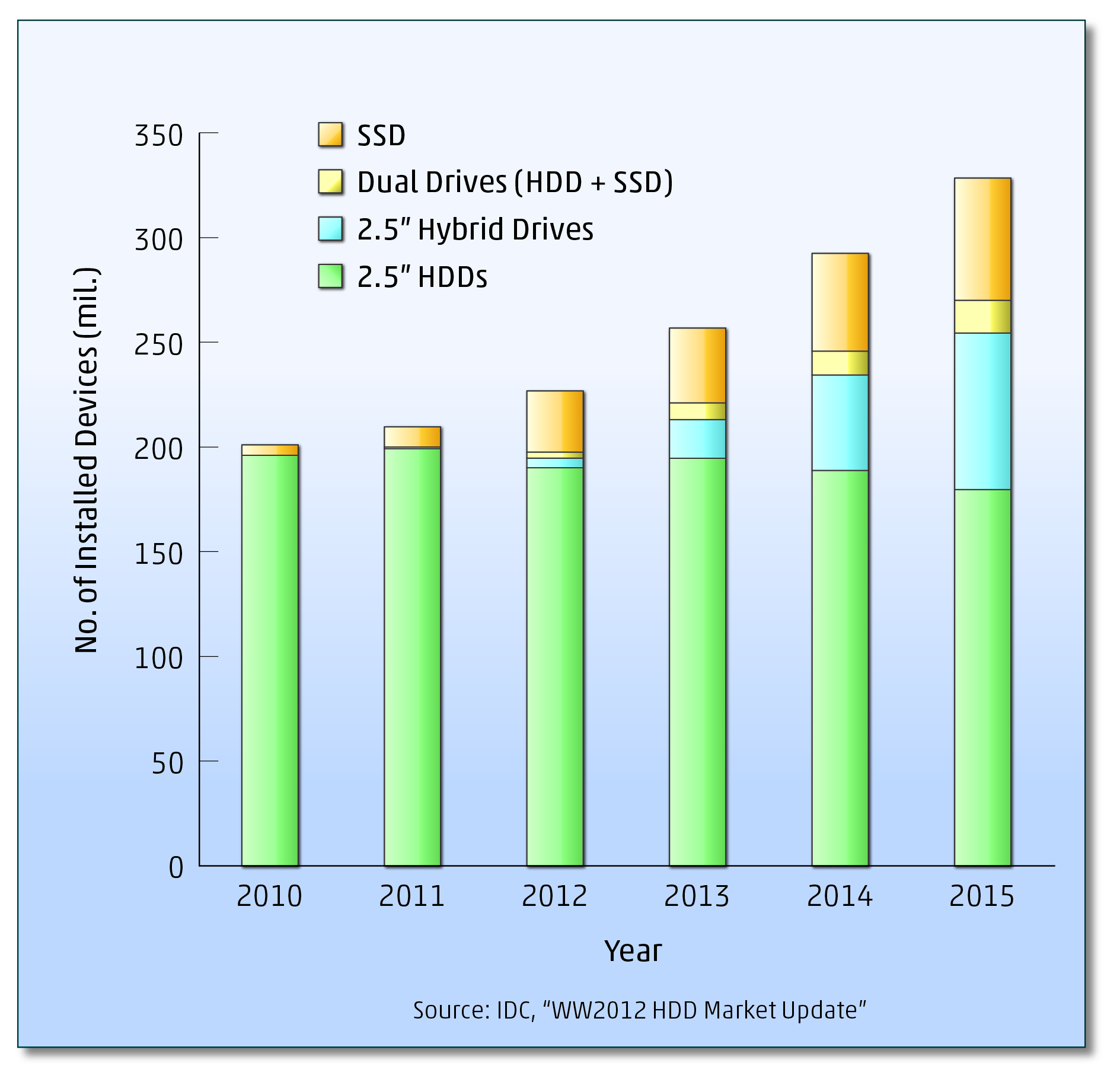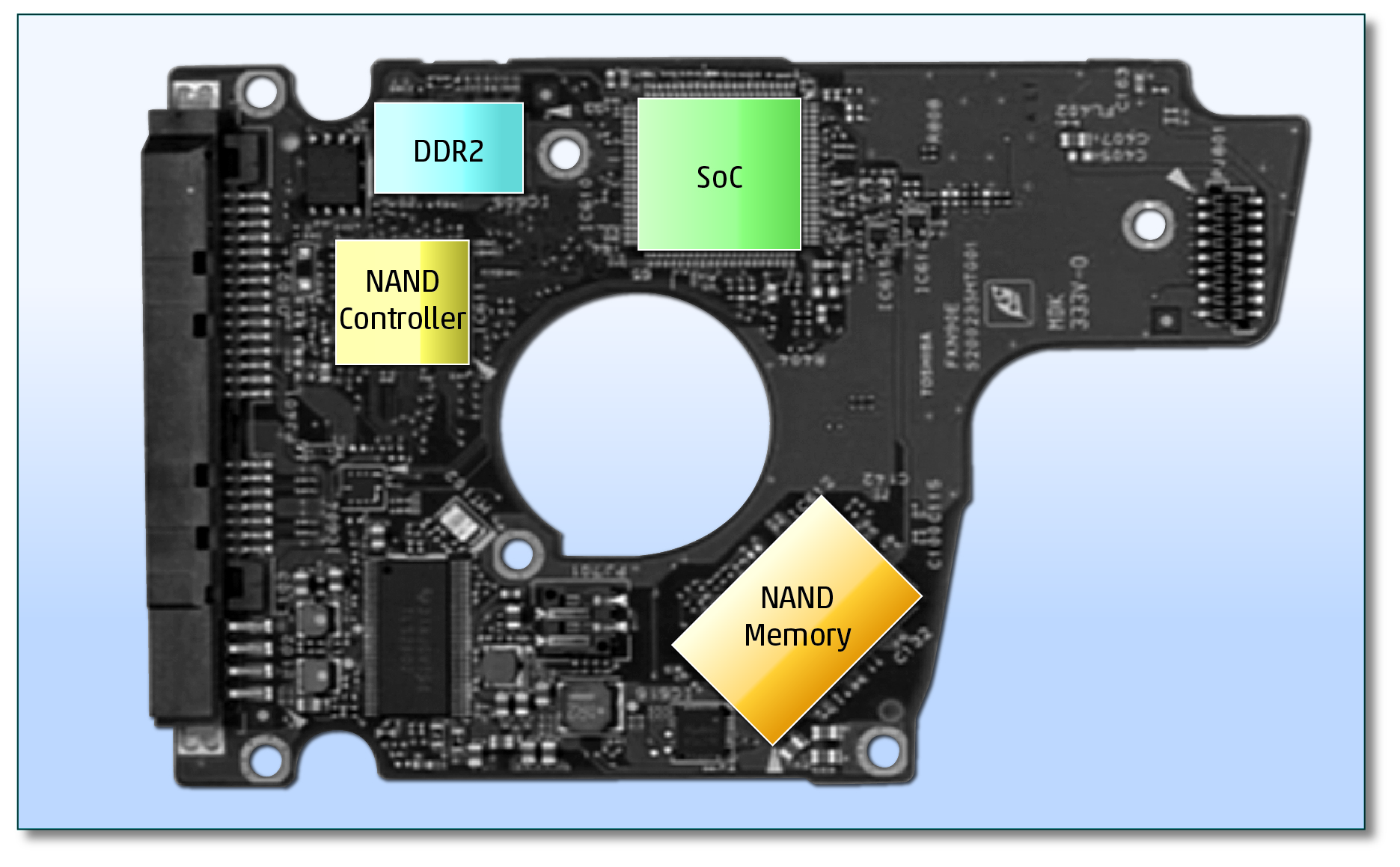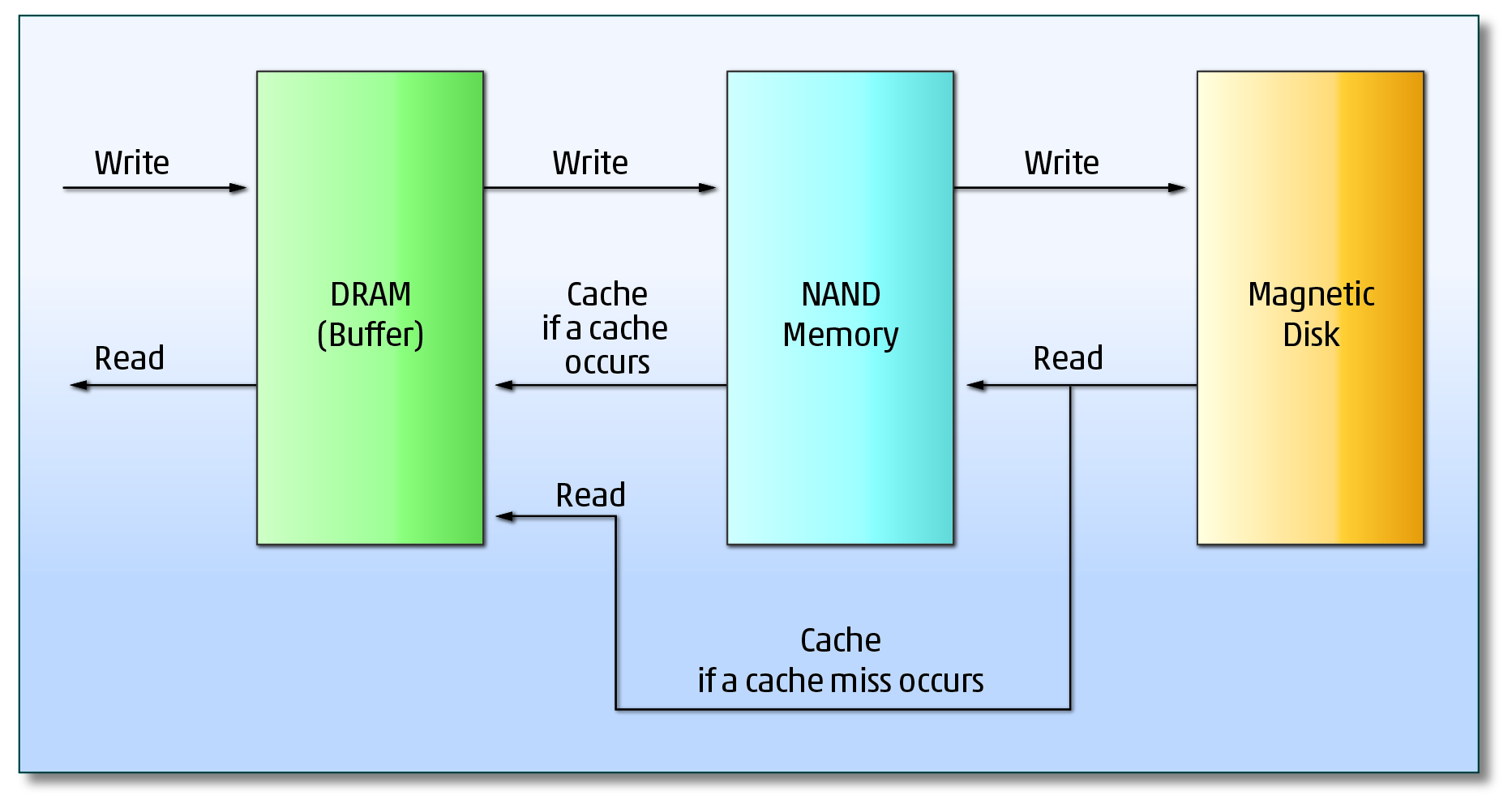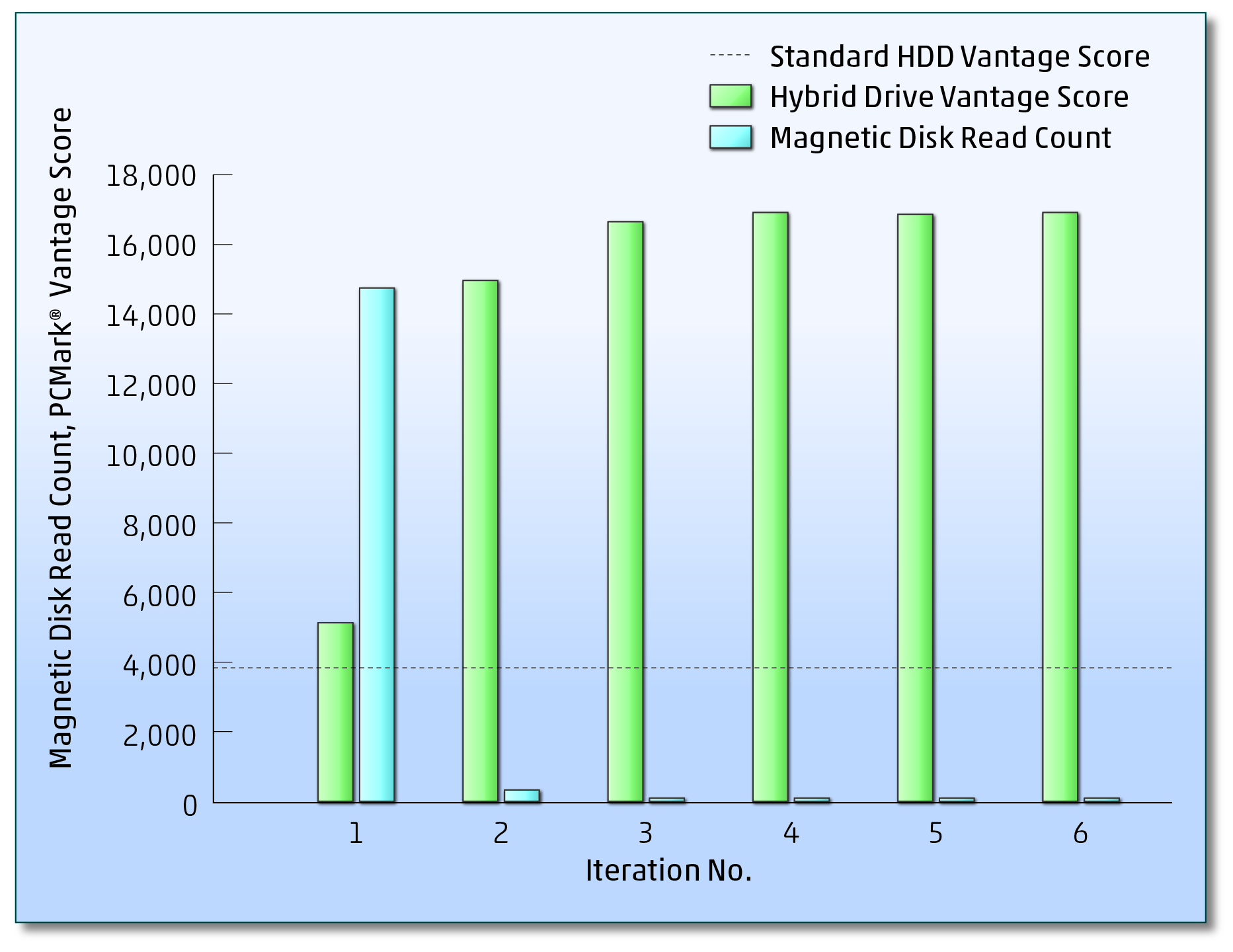Hybrid drives capacity and performance
The hybrid drive combines the cost advantage of rotating magnetic disc storage with the high performance of NAND flash memory. This new technology has recently been attracting attention from computer users looking for fast, large capacity drives. Mine Budiman, Eric Dunn & Rick Ehrlich, Toshiba Storage Products Division, explore more in this article from ES Design magazine.
The combination of a hard disk drive (HDD) and NAND flash memory has the potential to deliver a solid-state drive (SSD) like user experience. Hardware, firmware and architecture design are all essential to creating a product that will meet user expectations in terms of performance, capacity and cost. In the case of the latest technology, for example, that includes developing a new cache algorithm that places frequently used data into NAND flash memory, resulting in a hybrid drive with SSD-like performance.
Large numbers of video and other types of data are being handled more frequently than ever before. People want to store more data on devices installed in PCs (e.g., HDDs), yet still achieve increased data access performance. For example in operating system (OS) data readout performance for quick booting PCs, as well as improved data read/write performance while PCs are in operation. HDDs are still the major player in the storage device arena and are used in numerous fields, though there are limitations on performance improvement potential. For this reason, SSDs, which feature high-speed data access, are attracting attention and the SSD market is expanding. However, HDDs still have the advantage in cost per gigabyte. Given these circumstances, Hybrid drives, which combine HDDs with NAND memory, have come into their own as storage devices capable of realising both high capacities and high performance. Now, by adopting an intelligent cache algorithm that learns what data should be stored in the NAND memory cache, the latest generation of these drives is set to deliver HDD capacity and SSD-level performance to both enterprises and consumers.

Figure 1: The number of hybrid drives built-in to notebook PCs is predicted to increase greatly by 2015
The hybrid drive achieves both a high capacity and high performance by combining traditional NAND memory technologies, NAND memory handling technologies (instrumental in SSD technologies), and HDD product development technologies. Full-fledged adoption of hybrid devices are estimated to account for about 25% of the market in 2015 (Figure 1).
For the cache memory, the HDD uses low-capacity, high- speed DRAM (volatile memory) and a large-capacity magnetic disk (non-volatile memory). NAND memory (non-volatile memory), which has medium capacity, read/write speeds and bit costs compared to DRAM and magnetic disks, is added as a secondary cache in this HDD.
A newly developed cache algorithm dynamically studies data access patterns and stores frequently accessed data in non-volatile NAND memory. This allows access performance to be improved even if no cache hits occur in DRAM during use, for example when booting the PC. Thus, the algorithm can help the hybrid drive achieve performance levels close to that of SSDs.
PC systems recognise the hybrid drive just as they do conventional HDDs and SSDs. There is therefore, no need for additional software and existing HDDs or SSDs can be replaced directly with this drive.
Hardware development
In order to keep hardware costs low while achieving high performance, Toshiba has developed a NAND controller for managing data read/write to and from NAND memory. This controller serves as a bridge chip positioned between the System on a Chip (SoC) and NAND chip. The NAND controller and Synchronous DRAM (SDRAM) are connected in parallel to the Double Data Rate 2 (DDR2) SoC interface; different address spaces are allocated to the NAND controller and SDRAM to allow the existing HDD and NAND chips to share the SoC.
To avoid totally redesigning the HDD the aforementioned NAND controller and NAND memory need to be mounted onto the HDD circuit board. The conventional four-layer printed circuit board has been changed to a six-layer board allowing the components to be mounted on the same size board as that used by the standard HDD as shown in Figure 2.

Figure 2: The NAND memory and NAND controller are mounted on a board the same size as that of HDDs by using small-sized SDRAM and increasing the number of layers in the multilayer board
The amount of space needed to mount the components was further reduced by adopting small sized DDR2 (rather than DDR1) for SDRAM. However, it was impossible to mount more than one NAND memory module. The candidate NAND memory modules and a performance comparison of sequential write operations are shown in Table 1. With respect to NAND memory, single level cell (SLC) technology has a higher cost of capacity per unit than multi level cell (MLC) technology, but also offers much higher performance. If the number of dies (NAND chips) is increased, the drive’s performance will be improved considerably because of parallel processing. Since this hybrid drive could not include more than one NAND memory, a cost/performance trade-off analysis was performed, which selected the 8GB SLC (which uses four 2-GB dies).
In typical HDDs, random access performance is restricted by seek-times and rotational delays; in most cases, command reordering techniques are used to minimise the impact of these delays, but HDDs are still limited to 200-300 Input/Output per second (IOPS). NAND memory performance is restricted by the access speed to the NAND memory, but this can be improved by increasing the number of channels and the number of dies to enable parallel access. With such techniques, it is possible to enhance the random read/write performance of NAND memory up to several thousand IOPS, an order of magnitude better than that of a standard HDD.
Software development
The capacity of the NAND memory mounted on the hybrid drive is 8GB, approximately 1% of the capacity of a 1TB HDD. Effective use of NAND memory as a cache requires careful consideration of what data to place in the NAND memory because of the limitations imposed by its capacity. The hybrid drive’s design concept is shown in Figure 3.

Figure 3: Data is controlled so that recently written and read out data is stored in NAND memory, allowing read/write speeds to be improved
The hybrid drive consists of the following three storage tiers: SDRAM, NAND memory, and magnetic disk, each of which has different read/write speeds. When the system requests that data be written, the hybrid drive will write the data to the NAND memory before writing the data to the magnetic disk (data will be written to disk later). When the system requests that data be read from a specific address, the drive will check whether the data for the specified address is stored in NAND memory. If the data is present in NAND memory, the drive will quickly send the data to the system. If not, the drive will read the data from the magnetic disk and send the data to the system, then copy the data to NAND memory. Because of this algorithm, data that was recently written to the Hybrid drive or read out from the drive is contained in NAND memory. If the system requests that data be read from the same address again, the drive can return such data to the system very quickly because the required data is stored in NAND memory.
Using a hybrid drive prototype with a 16GB NAND memory a series of six iterations was conducted with the performance-benchmarking tool (PCMark Vantage HDD Suite). As for the benchmark results, the relationships between benchmark scores and magnetic disk read counts are shown in Figure 4. The Hybrid drive must read data from the magnetic disk if the data is not stored in NAND memory. After the second measurement, the magnetic disk read count decreases dramatically, since most of the data is read out from NAND memory. In the first measurement, the benchmark score is only slightly better than that of a conventional HDD, but the scores for subsequent benchmarks exceed those for the first measurement by a factor of three. These scores are the result of studying the system’s data access patterns and caching the necessary data into NAND memory.

Figure 4: Benchmarks show a score increase of about 3 times that of a convetional HDD
The development of a hybrid drive containing three storage levels comprising SDRAM, NAND memory, and magnetic disk answers the need for many users of fast, high capacity storage. By utilising an algorithm that controls how and where data is stored and cached, SSD-comparable performance can be achieved for repetitive access cycles such as OS access times during PC boot sequences.
To further improve hybrid drive performance, a specification for standardisation of hints, which are data provided by PCs that give hints as to whether to keep data in NAND memory, is now being discussed at the Serial ATA International Organization (SATA-IO), the standard-setting organisation for Serial Advanced Technology Attachment (SATA). In the NAND memory field, efforts to reduce costs by integrating components and miniaturising processes are currently underway.
Toshiba continues to improve the cache algorithm to intelligently exploit the 3-tiered structure of SDRAM, NAND memory, and a magnetic disk, and also to develop second-generation hybrid drives with even higher performance.











